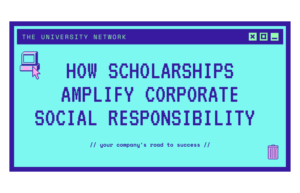From Ford to Pfizer, most major companies offer a scholarship under their brand name. But why do they choose to do so?
The benefits to the recipients are obvious. The benefits to the recipients are obvious. U.S. borrowers collectively owe about $1.7 trillion in outstanding student loan debt. About 44 million students borrow to pay for college, with the average undergrad borrowing about $30,000.
But businesses can also benefit from giving away scholarships. Offering a scholarship can assist with marketing, CSR, SEO, recruitment, and everything in between, providing a huge return on investment for companies who implement them while also making a real difference in students’ lives.

Need help with your scholarship?
The University Network is happy to help you. Just give us a call at (917) 397-2650, or schedule a time to talk to us below:
Here are a few ways that a brand scholarship can benefit your business.

Brand scholarships can help you advertise for cheap
It’s no secret that advertising is both important and expensive. In 2024, it is expected that U.S. companies will spend about $422 billion in ad spending, according to Statista.
In short, there’s a lot of money in marketing, making it difficult for small businesses to compete. As a result, small businesses need to utilize outside-the-box advertising strategies and solutions.
A scholarship program is a great example of an unconventional and yet effective advertising tool that can provide a strong return on investment for companies that implement them.
For an example, let’s look at one of the most successful brand scholarships, Taco Bell’s Live Más Scholarship, a huge program that is giving away more than $7 million in scholarships to students across the United States this year. Taco Bell’s program is a great example of a scholarship that has provided its company with a quantifiable return on investment and substantially increased sales.
In 2023, the program’s most successful year yet, nearly 14,000 students submitted applications. But that figure only speaks to one facet of the program’s success.
The program also drove over 170,000 store visits. Those sales allowed Taco Bell to make an additional $500,000 donation to the scholarship fund due in part to increased media awareness as well as sales generated by the campaign.
Part of Taco Bell’s Start With Us, Stay With Us initiative, an education and career-building program, Live Más has been so successful that Taco Bell is awarding $10 million for the 2023-24 program.
Brand scholarships can strengthen connection with young people
A large part of the reason that scholarships are so useful as a marketing tool is the age group that they appeal to.
In October 2023, there were 11.9 million college students and 9.5 million high school students, according to the U.S. Bureau of Labor Statistics. In any given U.S. state, between 30 and 50 percent of 18-24 year olds are enrolled in college. That is a large and desirable market, and yet it is one of the hardest for marketers to reach.
Young people are inundated with advertisements, have relatively short attention spans and a strong filter for advertisements, and are wary of brands and large corporations. A recent survey of millenial and Gen Z consumers from 42 countries around the world found that young people are largely skeptical of businesses. The survey, conducted by Deloitte, found that only a slim majority (55 percent) believe that business has a positive impact on wider society, down from 61 percent in 2018 and four straight years of over 70 percent from 2014 to 2017.
Furthermore, they are more willing to engage with brands that they know are socially conscious. Forty-two percent of millennial survey respondents said that they have “begun or deepened” a relationship with a company because they believe it has a positive impact on society. Meanwhile, over 50 percent of Gen Zers see themselves as socially conscious and say that knowing if a brand is socially conscious influences their purchasing decisions. By 2020, Gen Z will represent 40 percent of American consumers and possess around $143 billion in spending power.
In order for businesses to reach this massive group of consumers, they need to speak to the issues that matter to them and demonstrate that they are motivated by more than just profit.
Now consider this: millennial borrowers, ages 25-34, collectively share $497.6 billion in outstanding student debt (among 15.1 million borrowers). Gen Z, the oldest of whom are 22 years old and just leaving college, already have an average debt of $14,700, the main source of which is student loans. This is largely due to the skyrocketing cost of college, which has increased 68 percent since the 1999-2000 academic year. And students are not receiving enough financial aid to cover the expenses.
There are few better ways to make an impression on a hard-to-reach, socially conscious, and soon-to-be-indebted age group than to make a direct impact on their lives through scholarships.
Brand scholarships can generate interest on social media
Scholarships are a particularly effective tool for marketing via the internet and social media.
As the public square of the 21st century, social media can either be a huge asset or a major liability for brands. A brand can go viral for all the right or all the wrong reasons. Social media marketing is a tricky business, but a strong social media campaign can pay enormous dividends for a company — just ask Popeyes, which gained $65 million in equivalent media value and lifted third quarter sales by 15.6 percent after its chicken sandwich went viral on Twitter.
Now, we can’t promise that a scholarship program will create that kind of return, but it can certainly drum up some attention on social media if executed in the right way. Scholarships naturally generate interest from students as well as schools (both high schools and universities), which are compelled to spread the word about them to their students.
A scholarship may attract some social media discussion on its own, but there are also strategies to ensure that it will generate buzz. Consider requiring applicants to produce a video and either publish it on YouTube or share it on social media. To attract more applicants and increase the likelihood of it going viral, make your scholarship easy to apply to and base it around a clever premise or project.
For example, the brand Duck brand duct tape created the Stuck at Prom Scholarship Contest, which offers a scholarship to the student who creates the best prom outfit out of their product. Whoever makes the best tuxedo or dress out of Duck’s duct tape wins.
Duck’s duct tape scholarship contest is immensely successful and has been circulated extensively via both social media and traditional media. The effect is two-fold: it functions as an advertising campaign and it also helps build a positive brand image among the public by showcasing the company’s philanthropic efforts. As a result, it can do a lot of the legwork that comes with building a positive perception and generating positive news around a company.
Brand scholarships can strengthen your CSR program
There is a strong movement across all industries toward embracing socially responsible business. This is broadly referred to as corporate social responsibility, a catch-all term for a business model that prioritizes sustainability and social consciousness. CSR is not only about building a positive brand image but about creating real impact and demonstrating that your company is one that prioritizes not just profits, but also people and the environment.
And the numbers show that it’s good for business.
Consider, for example, the findings of a 2019 study conducted by Cone Communications, which found that 72 percent of consumers believe it is more important than ever that companies they buy from reflect their values. Furthermore, companies that demonstrate a real commitment to CSR outperform companies that do not, with a return on assets 19 times higher.
Every company should include a brand scholarship in its CSR program. A scholarship can be the centerpiece of a CSR program or a supplemental initiative to a robust CSR program. Major companies have successfully employed both approaches, and seen their brands benefit as a result.
Canadian telecommunications giant Rogers Communications launched the Ted Rogers Scholarship Fund in 2017, which in 2019 awarded 150 scholarships of up to $10,000 to students across Canada, and has provided $3.5 million in scholarships to 1,000 recipients since its inception.
Rogers Communications has an extensive CSR agenda that also includes environmental initiatives and various charitable donations. But the company’s commitment to education via the scholarship fund and donations to grade schools forms the backbone of its program.
The fund is in large part a tribute to the company’s founder Ted Rogers, who was a noted philanthropist and proponent of education.
While discussing the program and the value of supporting higher education, Peter King, the senior CSR director at Rogers Communications, said, “There wasn’t much question where we would focus. Education and scholarships are a tremendously worthwhile cause, and we have this great story of a founder who believed that an educated nation is a strong nation.”
Rogers Communication made higher education the priority of their CSR program, but other companies have used them to augment their existing programs.
Annie’s Homegrown, the organic food company known for its macaroni and cheese and bunny rabbit logo, offers a sustainable agriculture scholarship for undergraduate and graduate students studying organic and/or regenerative agriculture. The scholarship highlights its commitment to supporting research in sustainable agriculture and also strengthens its brand as a company devoted to organic foods.
Northwestern Mutual’s Foundation, which funds research on childhood cancer, also offers a scholarship for cancer survivors and their siblings, called the Childhood Cancer Survivor and Sibling Scholarship Program.
All three examples demonstrate different ways that companies can utilize scholarships within their CSR programs in a genuine and impactful manner. Furthermore, because scholarships can gain a lot of publicity from universities and students (see the sections on advertising and social media above), they can help broadcast your CSR goals and efforts to consumers.
Brand scholarships are indispensable for reputation management
Just as a scholarship can help a company build its brand and represent itself in a positive light, it can also help rebuild a brand when things go awry. In a 21st century marketplace that is mediated by the internet, a company’s reputation is largely out of its own hands and in the hands of anonymous reviewers on forums like Yelp or Glassdoor. Bad press can spread like wildfire over social media and is capable of doing immense damage overnight.
In fact, companies can lose up to 22 percent of their customers if just one piece of negative content appears on the first page of search results. If four or more pieces of negative content appear, that figure rises to 70 percent.
As a result, every company needs a strategy to manage its online reputation. This begins with managing search results. Offering a scholarship can help you control what people see when they search for your brand. Scholarships often place well in searches due to the high level of interest they often generate and the high-quality backlinks they often earn due to universities linking to them. This is particularly true for small businesses or organizations that otherwise don’t have a particularly strong online presence.
For example, a scholarship offered by Fontana Transport, a trucking company based in California shows up high — the second and fourth results — in Google searches for the company name.
Moreover, when people search for your company, they will see your scholarship automatically appear in Google’s search suggestions (this feature is known as auto-populate), so people will be able to learn about your scholarship before they even hit enter.
The more effort put into publicity and SEO for the scholarship page, the higher it will rank in search results. It is simply good PR, and customers will associate your brand with good causes.
Brand scholarships can boost your SEO
All SEO experts know the value of .edu backlinks. Search engines view websites with .edu domains as reputable sources and therefore gives them a high domain authority, a rating that dictates how the site will place in relevant searches. As a result, .edu pages place highly in search results compared to other domains.
Why is this relevant? Because websites with a high domain authority also boost the authority of pages that they link to. These kinds of links are known in the SEO community as backlinks.
Authoritative, reputable backlinks help boost the profile and authority of a webpage and in effect increase organic traffic back to the site. As a result, strong backlinks are considered a valuable commodity in the world of SEO, and it can be difficult to use them in an effective way.
One strategy for acquiring reputable backlinks is called “scholarship link building.” Scholarship link building involves setting up a scholarship to try to increase links back to your site from universities, which often list scholarships provided by external sources on their websites.
Scholarships can provide a huge return on investment for companies who utilize them for link building. If properly marketed, a scholarship can earn over 100 backlinks, many from .edu sites with a high domain authority.
In order to have that kind of success with a scholarship link building campaign, you’ll need to effectively strategize and target the right universities. But a well-executed scholarship program can have a major impact on a company’s SEO value.
Brand scholarships are useful for market research
Scholarships can also be used to gather relevant information about your company’s customer base. Every year, companies around the world collectively spend tens of billions of dollars on gathering information about consumers through surveys, interviews, focus groups, and data analysis. These kinds of studies can cost anywhere from a couple of thousands to tens of thousands of dollars.
One overlooked, but cost-effective, way to perform market research is by offering a brand scholarship that includes a targeted prompt or a survey as an application requirement.
For example, Modern Castle, a website that reviews home products, offers a scholarship in which students are asked to answer the following questions:
- While you were growing up, what aspects of your home felt modern?
- What technological trends do you think will most dramatically impact the way the modern home runs in the future?
- What aspects of the home do you feel are the most in need of modernization? Using current and/or near-future technology, how would you modernize it?
These questions ask students to reflect on trends in the industry Modern Castle covers, providing it with insight into the minds of consumers, and by extension, their readership. Prompts like these can be thought of as a disguised survey question, and a variety of different kinds of companies could employ the same basic strategy for their specific industry.
Another option is to have students fill out a market research survey in order to apply. In this case, the scholarship could be fashioned as a so-called “lottery scholarship,” an easy-apply scholarship that chooses students randomly rather than based on grades or an essay competition. Websites such as Scholarship Points operate on this model — students simply fill out a survey to enter a drawing to win the award.
Because these scholarships are so easy to apply to and don’t limit the number of applicants, they can garner thousands of applications, and businesses can tailor the survey questions to gather the same information they would get from a focus group.
Brand scholarships can boost app downloads and website signups
Engaging new customers is one of the timeless challenges in business and one that has grown ever more complex in a competitive online business environment.
If a business is based around a digital product, traditional advertising will only go so far. For example, a company that has produced an app will need to spend an estimated $200,000 in paid advertising dollars to crack the top 25 results in U.S. iOS ranks, according to data from mobile marketing firm Fiksu. Those kinds of expenses are simply unfeasible for the vast majority of app developers.
Offering a scholarship can function as a clever tactic to increase app downloads or promote an online service. A software company might, for example, require downloading free software or a free app as part of the application process (note that a scholarship cannot require a fee to apply). In effect, you are manufacturing not only interest but engagement with your product by offering a scholarship.
For example, Movavi, a company that produces video editing software, offers a scholarship in which students apply by creating a video using their video-editing software and sharing the video via their social networks. In effect, the scholarship not only increases engagement with their product but also increases brand awareness on social media.
The same concept translates to website sign-ups. For example, Cirkled In, a student portfolio platform, offers a scholarship that students can apply for by creating an account and building a portfolio using their service.
There are nearly 20 million students enrolled in undergraduate and graduate programs in the United States. While it’s unreasonable to expect to reach anywhere near every student, it is NOT unreasonable to expect to reach hundreds, if not thousands, of students to apply. That means a whole lot of new customers.
Brand scholarships can generate product feedback
A scholarship can serve as an opportunity for companies to get honest feedback from students on their products and services.
TUN’s own Broke College Student Scholarship serves as an excellent example of this kind of scholarship. We asked students to use one of our products — the Student Save Engine, a search engine that helps students find student discounts and coupons — and create a short essay, video, or infographic describing the best deal they found it and how it helped them, or to identify products and brands they liked that they couldn’t find on it. This short prompt attracted thousands of entries, giving us a wealth of valuable information about how people use our platform and how we can strengthen our service.
This same concept can be modified for different kinds of businesses. For example, a news source might ask students about what kind of news they want covered and how they can improve their coverage.
An app or software company could offer a free download of their product and ask students to respond to questions about its performance. In this sense, a scholarship could be used as a form of beta testing.
App developers can spend anywhere from $2,000 to $20,000+ on beta testing, depending on the scale and specificity of the target audience for the test. One of the biggest struggles in beta testing is actually finding enough participants. If you invite 100 people to participate in a beta test via email, half might actually click through the invitation, of which half may actually register, of which a small percentage will actually complete the test. In order to motivate people to actually dedicate their time, you may have to provide some sort of incentive in the form of a cash prize or a reward.
If students or college-aged participants are your target consumer, a scholarship is an easy way to encourage people to participate in a beta test. While the average person might need an incentive to participate in a beta test, the incentive in this case is the chance to win a scholarship. It is the same principle that guides the surveys-for-scholarships model employed by websites like Scholarship Points. In this scenario, rather than survey information, you are getting ready and willing beta test participants.
Brand scholarships can function as a graduate recruiting program
Finding promising young talent is crucial for businesses of all types. Offering a competitive scholarship is a great way for companies to connect and build relationships with talented students from a young age.
Businesses can tailor their scholarship programs to reflect their own needs and find future graduates whose skills fit their organizations. Take the case of Frankel Loughran Starr & Vallone LLP, for example, whose scholarships are targeted towards students with an interest in accounting or taxation. Tech companies likewise might offer computer science scholarships to young developers. Doing so helps raise the company’s profile among high-achieving students.
Businesses can also choose to partner with specific universities to establish a relationship with related departments.
Scholarship recipients may be given the option to apply for internships or positions with the business throughout college and upon graduation. Companies with many highly-educated workers might choose to offer a scholarship for graduate students.
In any case, a brand scholarship program can put a business on the map for the best recruits and establish the company as an organization that is willing to invest in the next generation of employees.
Making a real impact
The cost of college has increased 1,120 percent since 1978, making it effectively unaffordable for the average family, even as a college degree is increasingly necessary to enter the workforce.
As the cost of higher education nears crisis levels, it is time for businesses to demonstrate leadership on the issue.
Offering a brand scholarship is a natural and easy way for businesses to make a direct impact on the lives of students. With each scholarship granted, a student’s future gets a little brighter and the workforce gets a little stronger.
Fortunately, it’s also good for business.

Need help with your scholarship?
The University Network is happy to help you. Just give us a call at (917) 397-2650, or schedule a time to talk to us below:
Resources















